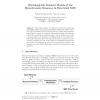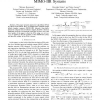29 search results - page 1 / 6 » Deconvolution of neuronal signal from hemodynamic response |
ICASSP
2011
IEEE
12 years 9 months ago
2011
IEEE
In this paper we describe a deconvolution technique for obtaining an approximation of the neuronal signal from an observed hemodynamic response in fMRI data. Our approach, based o...
IPMI
1999
Springer
13 years 9 months ago
1999
Springer
Today, most studies of cognitive processes using functional MRI (fMRI) experiments adopt highly flexible stimulation designs, where not only the activation amount but also the tim...
MICCAI
2005
Springer
14 years 6 months ago
2005
Springer
Abstract. Diffuse optical tomography (DOT) is a noninvasive imaging technology that is sensitive to local concentration changes in oxyand deoxyhemoglobin. When applied to functiona...
NIPS
1996
13 years 6 months ago
1996
We employed a white-noise velocity signal to study the dynamics of the response of single neurons in the cortical area MT to visual motion. Responses were quantified using reverse...
ISCAS
2007
IEEE
13 years 11 months ago
2007
IEEE
— This paper presents eigenvector algorithms (EVAs) for blind deconvolution (BD) of multiple-input multiple-output infinite impulse response (MIMO-IIR) channels (convolutive mix...


